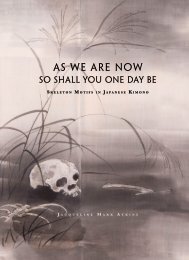Create successful ePaper yourself
Turn your PDF publications into a flip-book with our unique Google optimized e-Paper software.
140<br />
Shaped Sash or Votive Panel (partially complete)<br />
<strong>Mythic</strong>al Fox<br />
Pukara style, Sou<strong>the</strong>rn Highlands<br />
200 BC-AD 200<br />
Camelid wool (warp and weft); tapestry weave<br />
5" x 8½"<br />
Asmall body of inventively shaped tapestry weavings has<br />
been instrumental in defining <strong>the</strong> Pukara textile style,<br />
which is considered to be influential in <strong>the</strong> development of<br />
Tiwanaku art. They are believed to have been found at some<br />
distance <strong>from</strong> <strong>the</strong> Pukara ceremonial zone north of Lake<br />
Titicaca, however—ei<strong>the</strong>r in <strong>the</strong> western highlands, <strong>the</strong> south<br />
coast or <strong>the</strong> upper coastal valleys of <strong>the</strong> Arequipa region. Only<br />
some half-dozen pieces are documented, which are among <strong>the</strong><br />
most innovative and puzzling textiles in <strong>the</strong> Andean tradition.<br />
The textiles are also recognized for being <strong>the</strong> earliest evidence<br />
of <strong>the</strong> use of <strong>the</strong> interlocking tapestry technique, which became<br />
<strong>the</strong> foundation of <strong>the</strong> Wari tunic style. 1<br />
The panels are of unknown purpose, and were possibly made<br />
as talismans or accessories worn as part of a ceremonial or<br />
ritual ensemble. The imagery suggests <strong>the</strong>y were associated<br />
with trophy-head cult activities and beliefs.<br />
The textiles, which resemble two-dimensional reliefs or<br />
sculptural plinths executed in cloth, represent a striking<br />
syn<strong>the</strong>sis of form and image. The contoured weavings, entirely<br />
selvedged on all sides, outline <strong>the</strong> forms of mythical figures<br />
or animals. Details such as feet, hands, face and staffs or spears<br />
project into space. The curvilinear, irregular shape reflects <strong>the</strong><br />
use of a single continuous warp, although whe<strong>the</strong>r this was<br />
determined by <strong>the</strong> shape of <strong>the</strong> loom or some o<strong>the</strong>r approach<br />
is not clear (see Conklin 1983 for technical analysis).<br />
This panel is only partially intact but can be compared to<br />
ano<strong>the</strong>r extant, complete version. 2 Although <strong>the</strong> head is<br />
missing, <strong>the</strong> upright brushy tail appears to belong to a fox. In<br />
highland lore, <strong>the</strong> canid is actually regarded as <strong>the</strong> “younger<br />
bro<strong>the</strong>r" of <strong>the</strong> puma, but it has its own specific mythological<br />
associations within <strong>the</strong> feline symbolic complex. In <strong>the</strong> related<br />
piece, moreover, <strong>the</strong> animal is depicted holding a spear and<br />
ferrying a severed head (embellished with real human hair) in<br />
its mouth. Fortunately, one dramatic detail <strong>from</strong> that image is<br />
still preserved here, i.e., <strong>the</strong> headless, naked body of <strong>the</strong> victim<br />
draped over <strong>the</strong> rump of <strong>the</strong> predator.<br />
Ferocity is implicit, and this fox is evidently a supernatural<br />
sacrificer or agent of death. The skeletal ribs drawn on <strong>the</strong><br />
prone human figure typically also denote shamanic beings, as<br />
well as <strong>the</strong> dead (especially in Early Nasca iconography, which<br />
seems to have ties to Pukara). The bones apparently signal <strong>the</strong><br />
altered or transcendent state brought about by a ritual killing.<br />
The peculiar addition of an open beak to <strong>the</strong> stump of <strong>the</strong><br />
victim’s neck, conjuring a stylized bird head, underscores this<br />
message.<br />
The male victim appears to be a defeated enemy (ironically,<br />
he, too, carries severed heads in both hands). The pointed tip<br />
of an arrow or dart (top right) is <strong>the</strong> only surviving element<br />
<strong>from</strong> <strong>the</strong> “captured" bundle of weapons depicted on o<strong>the</strong>r<br />
versions. This <strong>the</strong>me appears elsewhere in Pukara imagery, a<br />
strong indication that ethnic conflict played a role in <strong>the</strong> rise<br />
of this highland culture.<br />
1 William Conklin, "Pucara and Tiahuanaco Tapestry: Time and Style in a Sierra<br />
Weaving Tradition," Nawpa Pacha 21, (1983).<br />
2 Margaret Young-Sanchez, ed., Tiwanaku: Ancestors of <strong>the</strong> Inkas (2004) 39-40: Fig 2.21.<br />
29



